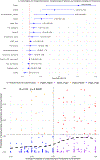Clinician Prediction of Hyperinflammatory Acute Respiratory Distress Syndrome Subphenotypes: Overestimated but Prognostic
- PMID: 40173283
- PMCID: PMC12264653
- DOI: 10.1164/rccm.202409-1816RL
Clinician Prediction of Hyperinflammatory Acute Respiratory Distress Syndrome Subphenotypes: Overestimated but Prognostic
Conflict of interest statement
GDK has received research funding from Karius, Inc., Pfizer, Inc., and Genentech, Inc. All other authors disclosed no conflict of interest.
Figures


References
-
- Kitsios GD, Yang L, Manatakis DV, Nouraie M, Evankovich J, Bain W, Dunlap DG, Shah F, Barbash IJ, Rapport SF, Zhang Y, DeSensi RS, Weathington NM, Chen BB, Ray P, Mallampalli RK, Benos PV, Lee JS, Morris A, McVerry BJ. Host-Response Subphenotypes Offer Prognostic Enrichment in Patients With or at Risk for Acute Respiratory Distress Syndrome. Crit Care Med 2019;47:1724–1734. - PMC - PubMed
-
- Heijnen NFL, Hagens LA, Smit MR, Cremer OL, Ong DSY, van der Poll T, van Vught LA, Scicluna BP, Schnabel RM, van der Horst ICC, Schultz MJ, Bergmans DCJJ, Bos LDJ. Biological Subphenotypes of Acute Respiratory Distress Syndrome Show Prognostic Enrichment in Mechanically Ventilated Patients without Acute Respiratory Distress Syndrome. Am J Respir Crit Care Med 2021;203:1503–1511. - PubMed
Publication types
Grants and funding
LinkOut - more resources
Full Text Sources

